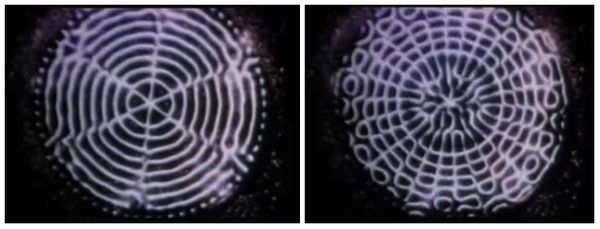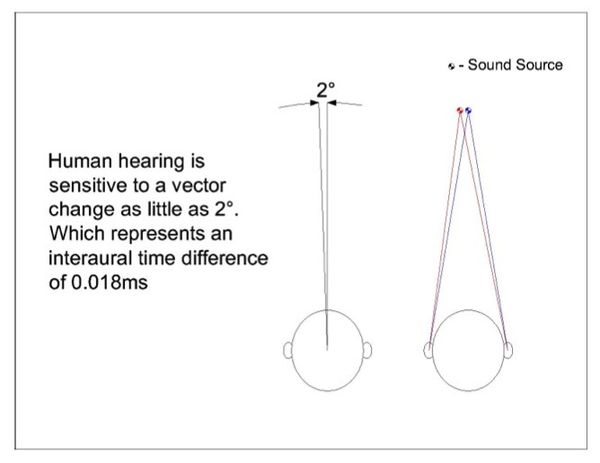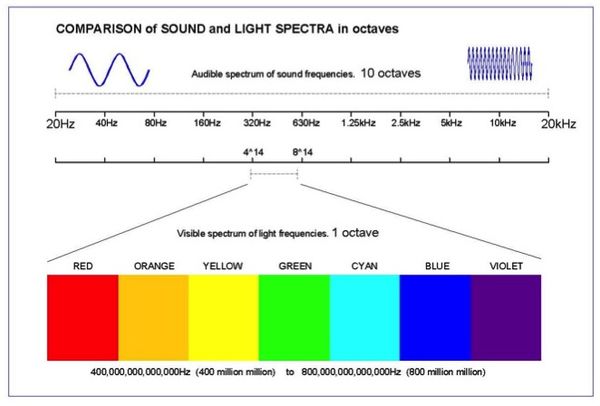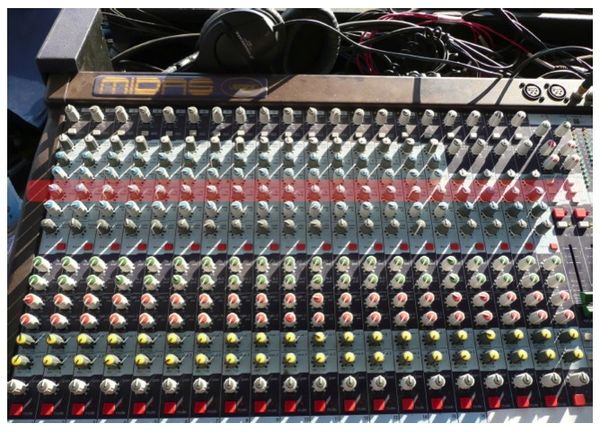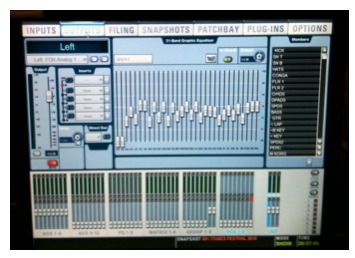Why Bad Sound is Disrespectful to Our Divine Nature
From MusicTechWiki
By:Tony Andrews
Sound is human interpretation of vibrations present in a solid, liquid, gas or plasma. These vibrations are waves of compression and rarefaction traveling through a medium typically air although they can also be heard and felt through water and earth. Our frequency perception is normally thought to be between 20Hz and 20 kHz. I would suggest that at around 100 Hz and lower the ears are less involved as the entire body takes over sensing or feeling bass frequencies.
One of the mysteries of the ‘big bang’ was how an exploding singularity could have developed sufficient texture to gravitationally form the galaxies which populate our universe today. It has recently been understood by cosmologists that it was the actual sound of the big bang coursing through the quark soup of the embryonic universe that caused the original ripples in its uniformity. At this point ‘In the beginning was the word’ takes on another dimension of meaning.
Om or Aum is the primary mantra in Hinduism representing as it does the sound of the universe. In Buddhism, Om is also viewed as the primal vibration out of which everything came into being and into which everything returns at the end of a cosmic cycle. Sound was present at the very beginning of the universe whereas light only appeared after 350,000 years when the temperature of the universe had cooled sufficiently to allow quarks to condense into matter and permit the transmission of photons. So it would appear that sound is of primary cosmic importance and is the bringer of form to the energy of the universe in possibly a similar way to a metal plate forming patterns in powder when vibrated with a violin bow.
Fig. 1 Cymatic Patterns
It is interesting to note that sound frequency and the diatonic scale are referred to in octaves. The 8 notes in the diatonic scale are at specific frequencies and they strike our sensibilities in a pleasing and harmonious manner, possibly because the relationship of the notes to each other represents a universal pattern that we are naturally in tune with. This universal pattern may be rooted in the structure of matter. The various elements are defined by the number of protons and electrons in one atom. The electrons are arranged in discrete orbital shells with 8 or multiples of 8 being the limit that an orbit can contain before a new one is developed at a specific distance from the previous orbital shell.
Fig. 2 Potassium Fig. 3 Calcium
These discrete relationships give rise to the field of Quantum physics. Furthermore the periodic table of elements illustrates the repetition of physical properties in an octave cycle.
Fig. 4 Periodic Table of Elements
So wherever one looks at fundamentals the cycle of octaves is present and illustrates the ultimate importance of music to our being.
The resolution of our auditory system is astounding and is able to provide us with a wide array of information about our environment and events within it.
Fig. 5 Interaural Time Difference
This is demonstrated by work done (I am informed by Dr Peter Lennox of Derby university) in determining the minimum detected angle of vector shift. In other words how much a sound source has to move before human hearing detects a change in location, using the difference of arrival times between the two ears. This turns out to be as little as 1 or 2 degrees in the horizontal plane which represents a timing arrival difference at the ears of 13 to 18 microseconds which is 13 to 18 thousandths of one thousandth of a second. In comparison a movie frame rate of 28 frames per second or 36 milliseconds is sufficient to give the appearance of continuity. This is over two thousand times slower than sound. So in terms of resolving power, sound is several orders of magnitude higher than light and on top of this it does it over a range of ten octaves whereas light is perceived across only one octave, the seven colors of the rainbow.
Fig. 6 Sound and Light Spectra
Furthermore, although common wisdom holds sight as our primary sense, it only perceives information from less than half a sphere through a relatively narrow window of electromagnetic wavelengths. Sound, however, is sensed full sphere. Light can also be switched off by closing the eyes or by darkness. Sound is a major contributor to our feeling of our location in space and the nature of that space, in a way that is not possible with light. Sound conveys a constant stream of information about events located anywhere in our audio sphere. The brain devotes considerable resources in unravelling and deciphering the location and nature of various sound sources. The brain would only use this much energy if sound was of major importance to man’s long term survival. We propose that at an early stage in human evolution sound would have emerged as the primary survival sense because it works just as well at night as during the day and in a jungle environment it is not blocked by trees and shrubs. Moving sonic events would be prioritized because of their indication of immediate danger, such as the possibility of being eaten, or alternatively the presence of possible lunch and is therefore more stimulating to the emotions than stationary sound.
Considering the refinement of human audio perception and the quantity of brain power necessary to process all this information it is remarkable what scant regard is afforded the audio environment of our present world. One can only recoil in horror at the average quality of electronic audio being broadcast to people all over the world. The reasons for this are manifold and include lack of education, poor equipment, misuse of equipment, corrupted audio sensibilities, vexatious music and just plain deaf. The result of this sorry state is that the communal musical audio experience rarely reaches its full potential and bad sound is quite normal.
A sound system is a chain of hardware from the microphone or sample to the loudspeakers and it remains fair to say that it is only as good as the weakest link in the chain. Therefore for good audio results every stage of the system and associated processes must be of sufficient quality. I’m sad to say that too many sound engineers are focussed on their computers rather than the art of listening and frankly they are failing their listeners, mixing with their eyes rather than their ears. One of the difficulties with this situation is that once a person becomes used to bad sound it is self perpetuating. The sound one works with is what one’s brain becomes accustomed or tuned to. Over a period of time our brains will apply the necessary EQ and adjustments to give an approximation of a perceived flat response which becomes habitual. After a while, even if a sound is superior, it will sound wrong because it is different. When listening to a new sound this habitual compensation gets in the way of what is really there and takes some time to unlearn or correct.
This picture shows the typical reaction of an engineer accustomed to compression driver tonality and distortion when faced with F1 cone driver technology. Nearly all the low mid is backed off in an attempt to make the system sound like what he has become accustomed to.
Fig. 7 Low-Mid Cut
High quality sound is clean and clear allowing individual sounds to have detail and separation, they are not smeared together. Low quality sound drives the listener away from the experience. High quality sound draws the listener into the experience where the precision of information allows the full bloom of musical feeling. The enemies of good sound are over compressed file formats, over loaded audio circuits in hardware, making tracks too loud at the expense of headroom, low audio quality electronics, bad engineers and bad speakers particularly the compression driver component present in the midrange of nearly all large loudspeaker systems. The unique cone midrange device that we invented to address this problem is one of the technological foundations of Funktion-one.
This picture of a graphic equalizer setting in well known London venue is an example of poor engineering practise. Introducing EQ also introduces phase shift which in this situation of up and down faders will be a mess and the resulting audio would have been better if the graphic had been left flat.
Fig. 8 Scary Graphic Equaliser!
When I compare an MP3 file to a CD quality wav file I hear bass that lacks low frequency extension and the tails of the notes are missing which altogether makes the sound weak and insipid. More annoying are the high frequencies which are the opposite of translucent and crystalline, being fizzy and crunchy. Low crossover point compression drivers have large amounts of inherent harsh distortion particularly when driven hard which is most of the time. For far too long many DJs have run their equipment with the meters in the red causing even more distortion from the overloaded output amplifiers of their mixer. This all adds up to a loss of space and dimension depriving the listener of involvement, feeling and spiritual motivation. Think of the difference between muddy and clear water or fog and a clear sunny day. With muddy water only the two dimensional surface is visible whereas with clear water one is able to see into it and appreciate three dimensionally the features within the water. When one is deeply, emotionally involved with quality stereo sound a space of light, color and energy can open up within and the listener becomes the sound. It is a place where much can be experienced and learned.
I hope I have managed to convey not only the breadth and scope of our sound perception but also its fine depth of resolution and its link through music to the fundamentals of creation.
